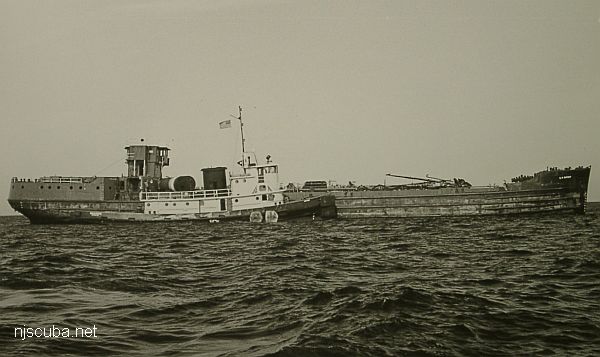AH Dumont YO-54

- Type:
- artificial reef, tanker
- Built:
- 1940, John H. Mathis, Camden NJ USA
- Specs:
- ( 247 x 38 ft )
- Sponsor:
- Spentonbush Red Star Company, Fisherman Magazine
- Sunk:
- Tuesday June 10, 1986 - Garden State North Artificial Reef
- GPS:
- 39°37.727' -74°01.079'
- Depth:
- 85 ft




"This ship, the A.H. Dumont, a commercial ocean-going tanker, was designed and built by Mathis. The design was used extensively by the Maritime Commission to meet wartime requirements. The A.H. Dumont is a typical example of Mathis Service from design to delivery."
The John H. Mathis shipyard at Point & Erie Streets in Camden was known far and wide for its yachts, and also produced ships for the Navy and Coast Guard. Famed yacht designer John Trumpy began building yachts at the Mathis yard in 1910 and remained there until he opened his own shipyard up in Maryland. During World War II a variety of ships were built, including minesweepers, transports, Coast Guard cutters, and ferries, among others. The Mathis Shipyard closed in the 1960s. The Mathis Shipyard was later used by a firm called Camden Ship Repair.
YO-54 Bailer
A tool used to remove cuttings and other material from oil wells.
YO-46 Bullwheel-class Fuel Oil Barge (self-propelled):
(YO-54: dp. 2,075 (f.); l. 213'6"; b. 37'; dr. 14'6"; s. 10.5 k.; cpl. 18; a. 1 .50 cal. mg.)

Early in the autumn of 1941, as the entry of the United States into World War II grew more probable, A. H. Dumont, a fuel oil barge constructed in 1940 at Camden, N.J., by the John H. Mathis Co., was slated for acquisition by the Federal Government; renamed Bailer and designated YO-54 on 2 October 1941; formally purchased by the Navy from Ira S. Bushey & Sons on 24 November 1941; converted to naval service by the Sullivan Drydock Co. and the New York Navy Yard; and placed in commission on 18 February 1942; Lt.(jg.) James F. Ardagh, USNR, in command.
Following outfitting, tests, and trials during the latter part of February, Bailer put to sea on the 26th and, after stops at Newport, R.I., and Boston, Mass., arrived in Casco Bay, Maine, on 12 March. From that time until early in the summer of 1945, the fuel oil barge operated in Casco Bay under the auspices of the Commandant, 1st Naval District, refueling ships of the Atlantic Fleet. Shortly after the surrender of Germany ended hostilities in Europe, she returned to New York in June 1945 and spent the period 10 July to 9 August undergoing repairs at the shipyard of her former owner. On 9 August, she received orders to proceed to Norfolk, Va., where she operated until the spring of 1946. On 21 April 1946, Bailer was ordered to Boston for inactivation. The fuel oil barge arrived at Boston on 30 April and was decommissioned there on 23 May 1946. Her name was struck from the Naval Vessel Register on 19 June 1946, and she was transferred to the Maritime Commission on 23 December 1946 for disposal.
Raymond A. Mann
from Navy historical records
** I have underlined two points which are simply typographical errors - the misspelled name, and the incorrect length. All other Bullwheel-class vessels are listed as 235 feet. Everything else matches up with the Dumont. The vessel could also have been lengthened with a 30-foot plug at some point in her later career.


The superstructure was cut off prior to sinking, leaving just a hulk, and an upside-down hulk at that! Surrounded by tire units.



Questions or Inquiries?
Just want to say Hello? Sign the .